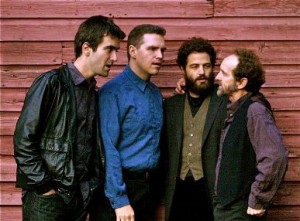(WILLIAMSTOWN, Mass.) – On Friday, February 24 at 8 p.m., Tenores de Aterúe, a Williamstown-based quartet, will share the unique style of Sardinian singing called cantu a tenore at St. John’s Church in Williamstown. Proceeds from the concert (which also includes music from Corsica and Italy) will go toward funding their first study tour in Sardinia planned for later this year.
When the members of Tenores de Aterúe first heard the strange guttural sounds and ringing overtones of cantu a tenore, they thought it sounded like something from another planet. In fact, it came from the voices of four men singing together on the island of Sardinia. They were instantly hooked, and wanted to try the unusual style out themselves. But they had no teacher, knew no one from Sardinia, and couldn’t even hear what the Sardinians were doing with their voices. “It was like an ocean of sound that had no beginning or end, no top or bottom,” they say.
Their desire to learn Sardinian songs remained a fantasy until 2008, when Carl Linich discovered a video on YouTube by the Sardinian group, Tenores di Bitti, with each voice part sung in isolation, and then together with the other parts. It was their rosetta stone. Avery Book and Gideon Crevoshay joined Linich and Doug Paisley. Book had already taught himself how to do guttural throat singing, and they know had their quartet.
Their first song came from the website of Tenores di Bitti, where they found the complete text to their recording of Ballu Dillu. They gathered at Crevoshay’s house in Brooklyn and started trying to make some sounds. It was not easy, and it took a while before they had something that sounded much like what they heard, but they kept working and gradually it started to come to life. The biggest challenge was the distance that separated them. Booky was living in Ashville, N.C. at the time. However, despite the geographic challenges, they managed to meet periodically and work up quite a few Sardinian songs.
In January 2011, they gave their first performance in Williamstown under the name Tenores de Aterúe (“Singers from Elsewhere” in Sardinian). They posted a video of their performance on YouTube, and the next day they noticed something unusual: the video started getting hits – hundreds at first, and then thousands – all from Sardinia. They received a message from Omar Bandinu, one of the singers in Tenores di Bitti, who had written an article about our performance in the Sardinian newspaper, L’Union.
Native Sardinians from around the world posted comments expressing astonishment (“I’m stunned”) and appreciation (“This is the best gift you could have given us.”) Tenore singers from small villages in Sardinia chimed in, offering encouragement and suggestions on how to improve. Their video was even featured in a documentary about cantu a tenore that aired on Italian television.
Designated a Masterpiece of the Oral and Intangible Heritage of Humanity by UNESCO in 2005, cantu a tenore is a form of polyphonic singing that is traditionally performed by a group of four men using four different voices: bassu, contra, boche (oche) and mesu boche (mesu oche). The deep, guttural timbre of the bassu and contra voices produce ringing overtones, which are expanded by the mesu boche. This rich aural texture is essentially a canvas for the boche, who is the main soloist and sings almost all of the text. The song form is typical of the region of Barbagia and other parts of central Sardinia. Performances are often spontaneous and done in local bars, but also at more formal occasions, such as weddings and religious festivities.
Canto a tenore covers a large repertoire; the lyrics are sometimes ancient, and sometimes contemporary poems on present-day issues such as emigration and politics. In this way, the tradition has remained alive and something that still connects closely to Sardinia’s past and present in equally strong measure.
This past January, Tenores de Aterúe gave two concerts in New York City, where they met Isabela Masala from the Sardinian-American cultural organization, Shardana USA. She wrote of their concert on Facebook and within a few days received a message from a well-known and respected tenore group in Sardinia called Tenores di Silanus Santu Larettu, who proposed a cultural exchange: they would host them in their village to study and perform with them, and in return, Tenores de Aterúe would host them for a tour in the US.
This exchange would be critical to Tenores de Aterúe’s own development: really, the only way for the members to gain a deeper understanding of cantu a tenore is to spend time with living practitioners of this difficult art. Their broader hope is that this cultural exchange will bring greater appreciation for the cantu a tenore tradition both in the U.S. and in Sardinia, where apparently the tradition is often misunderstood and neglected.

